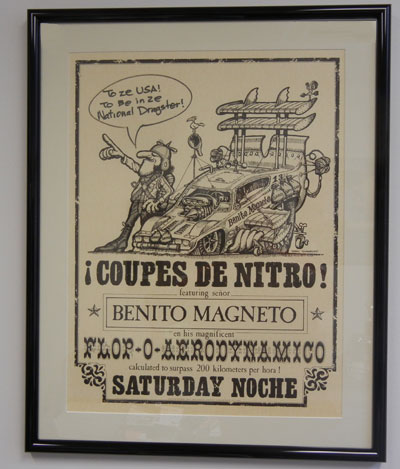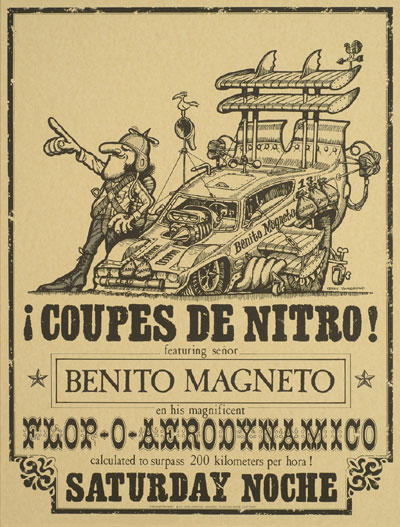

The Legend of Benito Magneto
 |
 |
I may have mentioned in a column or two over the winter that we moved our editorial offices downstairs to consolidate the Publications Department onto one floor of our humble little Route 66 salt mine and that we have new working quarters. When we first moved into this building way back in July 1993, as the bossman, I got first pick of offices and selfishly took the biggest and best, a corner office with a view of not just one but TWO parking lots.
Moving downstairs, I lost about a third of the office size and a view of those two parking lots. Today, I have just one window, from which, if you look out past yet another parking lot, you can see the Mother Road, Route 66. If my window opened, with a favorable wind, I could probably lob a red pen into the closest lane and hit Marty Milner's Corvette. But I digress.
The good thing about moving is that you get a chance to start anew, so when it came time to decorate my new office, I grabbed one of the many pieces of art we had hanging on the walls upstairs and claimed it as mine: Kenny Youngblood's amazing Benito Magneto print.
It's a faux promotional poster for an appearance by the aforementioned Mr. Magneto, an Italian Funny Car racer, and his rather tricked-out flopper. Ours is a personalized copy on which Youngblood has drawn a speech bubble coming from our hero proclaiming, "To ze USA To be in ze National Dragster!"
I've stared for a long time at the artwork, which is so unlike anything that the amazing Youngblood had done or has done since, and every time, I see something new. It's so rich in detail it's mind-boggling, and, as it turns out, Youngblood wasn't just accessorizing his car like some out-of-control J.C. Whitney catalog shopper; it turns out that he had purpose behind the madness, and a lot of thought went into what might easily be dismissed as a cartoonish drawing.
How do I know? Well, you know me. I got to wondering about the story behind the story, the kind of stuff I like to share here, so I dropped Kenny an email, hoping to set up an interview. He said he was busy that day – heading out to the March Meet – but he'd love to talk about it because he was planning to rerelease the print as part of his 'Blood Did It 45th anniversary world-tour souvenirs.
The next thing I know, instead of an interview, I got the entire story delivered into my lap, in the man's own words. Magnifico! So, without further ado …
The Legend of Benito Magneto
by Kenny Youngblood
 |
In the early '70s, when Funny Cars were breaking the 200-mph barrier, their lack of proper aerodynamics was causing some real problems. Most notably was Bob Pickett’s pass at OCIR, where the entire car literally “took off” in the lights, flying across the finish line!
The racers had to do something, and Bob Kachler had the solution! For his 1971 Hot Rod magazine article, Bob -- who was the creative genius behind Racing Graphis magazine -- had me do some drawings depicting what (we thought) was happening aerodynamically to the fiberglass-bodied coupes.
The article was all about areas of high and low air pressure and how adding spoilers would create sufficient downforce to keep the cars glued to the track. For the lead illustration, the good Lord gave me Benito Magneto and his Flop-O-Aerodynamico! Benito’s revolutionary Funny Car incorporated every possible innovation to generate “downforce,” and then some!
First of all were the car’s aerodynamic features, starting with the car's high angle of attack and severely chopped top, wedging it against the air (and necessitating the fender bumps). Next was the guy-wire-supported, double-element rear wing with vertical stabilizers and aero-shaped strut tubing. Added, too, were the double-element canard wings on each side of the car. Note that the car's unique header system was ingeniously designed to direct the hot exhaust gas against the underside of the top element, thus increasing the airspeed to reduce pressure and maximize downforce.
The car also had an extra-tall rear spoiler and ground-level front spoiler. The rear spoiler was so effective it obviously stressed its mounting bolts and the front spoiler so low that when the car was fully loaded and ready to run, it became somewhat less than ground level!
Not visible (behind the front sandbags) was a real grille opening that vented front-end air pressure out through the louvers in the hood. And finally was the addition of the aerodynamic, needle-nosed blower pulley!
Designed by Benito, the top pulley was made of magnesium and had to be machined in the United States (as no one could be found in Europe who worked with the exotic metal). So Benito sent the design to a young American racer named Steve Leach, who shipped the finished part back to Magneto’s secluded Palermo, Italy, race shop (which took over a month as much of its transport was by mule).

|
With the aerodynamic features in place, Benito then concentrated on static downforce.
Supplementing the lead weight bar on the front end and over the rear tires was Benito’s amazing and fully adjustable Sand Bag Static Traction System (SBSTS). At the hit, the weight of the bags optimized traction, which gave the car incredible 60-foot times (unfortunately, they didn’t have 60-foot clocks back then). Then, as the car gained speed and no longer needed them, Benito (utilizing a complex ratchet-lever system, which can be seen inside the car), would “eject” the bags as needed! The farther back the lever was pulled, the more bags fell off, lightening the car for its top-end charge!
Other unique features on the machine included the fully adjustable wheelie bar, the side-mounted dual parachutes, and the header-mounted “training wheels.” The wheels were designed to help stabilize the car when it got out of shape (an idea Benito got from watching Dave Condit drive the L.A. Hooker, using the side pipes as rockers). Also unique was the inclusion of a “brodie knob” on the half-round, '48 Alfa Romeo steering wheel (butterfly wheels were yet to catch on in Europe). The knob allowed Benito to steer the car with one hand while keeping the other on the sandbag-release lever.
To monitor the car's performance and measure existing weather conditions, the vehicle was equipped with a weather vane and wind sock for wind direction as well as a wind-speed indicator and aircraft pitot tube to measure air pressure. During a run, Benito would actually monitor the air pressure (downforce) indicated on the dash-mounted gauge and release the sandbags accordingly.
The car was quite successful and way ahead of its time, but, of course, there were some bugs.
The first problem was getting the car into the staging lanes for its maiden run as the static downforce systems eliminated the necessary ground clearance. This problem was overcome by using a dolly and making some simple adjustments to the suspension.
The next problem was a little more serious, or at least for the Sicurezza Safari (Italian Safety Safari), because, of course, the ejection of the sandbags required extensive cleanup. The Italian sanctioning body immediately imposed a penalty against the popular (and country’s only) fuel Funny Car team, but it was quickly rescinded (much to the delight of the fans). It’s not known for sure, but legend has it that Benito’s bodyguard (Johnny Limo Sr.) made the officials “an offer they couldn’t refuse” behind the timing tower (which had a slight “lean” to it, in honor of the tower in Pisa).
Other minor problems arose (like when the header flames burned the canard wings off the car), but none that couldn’t be easily resolved.
How far ahead of its time was it? Well, we think Jim Head would have been very proud of Benito as his machine incorporated a long list of innovations, innovations that would not be seen until, in some cases, many years later.

By the numbers: Flop-O-Aerodynamico
|
Benito Magneto’s 1971 Flop-O-Aerodynamico was the first to have or use:
1. A roof hatch (now mandatory on Funny Cars)
2. Double-element wings (now standard in Top Fuel)
3. Vertical stabilizers (now incorporated in Funny Car spoilers and Garlits' T-tail)
4. Guy-wire supports (used now on Funny Cars)
5. Front fender bumps (used in the late 1970s)
6. Dual, side-mount parachutes (dual chutes now mandatory)
7. Aero-shaped tubing for wing supports (now standard equipment)
8. A vented hood (used later on Don Schumacher’s Wonder Wagon Vega)
9. A weather station (now standard)
10. On-run data (now standard)
11. Dollies to move the car in the pit area (now standard)
 |
Benito was ahead of his time in the marketing arena, too: He had Europe’s first major nonautomotive sponsor; the Tums logo can be seen above the header cutout. And of course, Steve Leach went on to become the leading manufacturer of magnesium blower drives!
A few things didn’t catch on, like the aero blower pulley, the training wheels, the brodie knob, the rearview mirrors, and, of course, the sandbags, but all in all, it was a plenty trick piece.
Oh yes, Benito is pictured wearing another of his innovations that went by the wayside. It was a safety device “just in case” -- his firesuit/parachute combination. As it worked out, he didn’t need the parachute; the Funny Cars never flew again!
... and, that, ladies and gentlemen, is the legend of Benito Magneto. My thanks to Kenny for not only chronicling the life and times of Mr. Magneto, but also for his superb storytelling and writing ability that is just shy of his drawing talents.
Thanks for reading. I'll see you next week.



















































